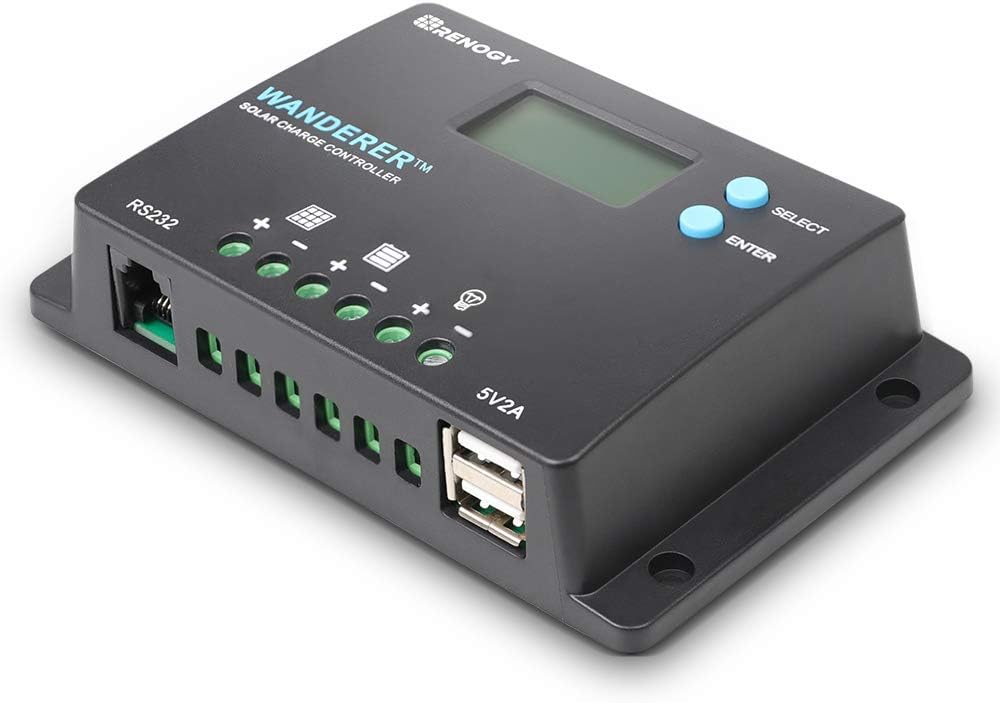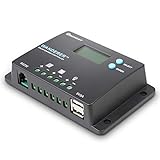Is it always necessary to have a Solar charge controller?
Typically the answer is, yes. You don’t need a charge controller with small 1 to 5-watt panels. If a panel puts out 2 watts or less for each 50 battery amp-hours, you probably don’t need a charge controller. Anything beyond that then you do.
For More info: Scroll Bottom of This Page
≋Our Top Pick Solar Charge Controllers≋
Renogy Wanderer 10 Amp 12V/24V PWM Charge Controller Regulator with Bluetooth Module
✭ Optimized for a 12V/24V system; Deep Cycle Sealed (AGM), Gel, Flooded and Lithium battery option ready.
✭ Smart 4-Stage PWM charging (Bulk, Boost, Float, and Equalization) – increases battery life, improves system performance.
✭ Intelligent protection against reverse polarity, overcharging, short-circuit, and reverse current.
✭ Backlit LCD screen displays system operation, diverse load control, and error codes.
✭ Integrated 5V 2A USB ports to charge USB devices.
✭ Compact in size makes it easy to install virtually anywhere.
✭ Integrated RS232 port allows communication with BT-1 Bluetooth module and usage of Renogy DC Home smartphone app.
ASIN: B07NPDWZJ7
Binen Solar Charge Controller 20A Intelligent Regulator 12V/24V PWM Adjustable LCD Display
✭ UL 1741 certified, the solar charger controller compatible with 12V 24V system.
✭ 10A, build-in industrial microcontroller, automatically manage the working of solar panel and battery.
✭ Dual USB output 5V/2.5A (max), to support mobile phone charging.
✭ The controller has short-circuit protection, open-circuit protection, reverse protection, over-load protection.
✭ Fully 3-stage PWM charge management, improve system efficiency and prolong the life span of the battery.
✭ The charge regulator is only suitable for lead-acid batteries: OPEN, AGM, GEL. It is not suited for nickel hydride, lithium, Liions, or other batteries.
✭ Comes with a display that can clearly indicate the status and data. Suitable for home, industrial, commercial, etc.
✭ Easy to Install and Operate (The charge controller should connect the battery first, then the solar panel, and finally the load).
✭ Dual mosfet Reverse current protection, low heat production. Note: The charge controller will heat up when it is running.
ASIN: B072MMDY4F
Autoday MPPT Charge Controller 40A-100A 12V/24V Auto Focus Tracking Solar Panel Regulator
✭ When the battery voltage is low – the controller will automatically cut off the load from the system. 
✭ When the voltage of the battery gets to normal the load will restart working.
✭ This MPPT charge controller has perfect SOC function, control charge current, and supply power to the loads.
✭ The system prevents the battery from over-charging, over-discharging, and reverse charging to solar panels during night hours.
✭ Compared with a normal solar charge controller, this MPPT controller could increase efficiency by 10%-30%.
NOTE: The regulator is only suitable for lead-acid batteries: OPEN, AGM, GEL; NOT suited for nickel-metal hydride, lithium ions, or other batteries.
ASIN: B07J25VWQS
PowMr 60a Charge Controller 12V 24V, Max 48V 1560W Input Adjustable Parameter LCD Display
✭ This charge controller compatibility with 12V and 24V system.
✭ Fully 4-Stage PWM charge (Boost, ABS, Equalization, Float), 12V(780W) / 24V(1560W) input.
✭ Dual USB can give your electronic product max 5V 2A.
✭ Backlight LCD display PV/ Battery/ Load charge and discharge parameter.
✭ Adjustable Floating voltage/ LVD/ LVR/ Load Timer according to the needs of this charge controller.
✭ Additional Features: Charge and Discharge Current, Charge and Discharge energy recording function.
✭ This charge controller fit for Lead-acid batteries (OPEN, AGM, GEL) with multiple load timers. The load should be DC.
✭ For protecting the lifespan of your battery, when the voltage drops below 8V, the controller will turn off automatically.
✭ PWM charge controller Protection – Dual MOSFET Reverse current, overheat, Under-voltage discharge, short-circuit, open-circuit, over-load, over-charging protection.
✭ More safe use for home, industrial, commercial, etc.
ASIN: B085VQN5RK
Morningstar SunSaver 6A PWM Solar Charge Controller for 12V Batteries, Built-in Diagnostics
✭ Designed for use in smaller systems. Max solar/load current: up to 20A (depending on model).
✭ Low voltage disconnect included (L models). Constant voltage PWM regulation; 4-stage charging.
✭ Ideal for use in cloud-connected network systems through communications protocols. 
✭ Tropicalized and hardened for field use with epoxy encapsulation, marine rated terminals.
✭ Meets UL/CSA requirements for Class 1, Division 2, Groups A-D for oil & gas, and other Hazardous Locations.
✭ T5 temperature rating for up to 100⁰C/212⁰F (boiling water).
✭ Built-in extensive electronic protection against the surge, short-circuit over-current, reverse polarity conditions.
✭ Advanced self-diagnostics warns against installation or user errors.
✭ The high-impact, durable polycarbonate exterior case illustrates industrial-strength build quality.
✭ The lowest hardware failure rate in the industry and backed by a 5-year warranty.
✭ Most Morningstar products ever built are still in use, some for over 25 years.
✭ Advanced thermal engineering eliminates cooling fans which can fail, suck in dirt, shorten component life and waste precious energy.
ASIN: B002MQL6L2
Renogy Adventurer Li 30A 12V/24V PWM Flush Mount Charge Controller with LCD, Bluetooth Module
✭ Unique USB port on the front display. The only Renogy controller with flush mount capabilities.
✭ RS232 port allows communication with BT-1 Bluetooth module and usage of Renogy DC Home smartphone app.
✭ Negative-ground controller Protection against overcharging, overload, short-circuit, and reverse polarity.
✭ 4 Stage PWM charging (Bulk, Boost, Float, and Equalization) prevents batteries from over-charging, over-discharging.
✭ 12V and 24v compatibility LCD screen for displaying operating information and data.
✭ Data compensates for temperature, automatically corrects charging & discharging parameters, improves battery longevity.
✭ Compatible with Sealed, Gel, Flooded, and Lithium batteries.
✭ The included Adventurer Surface Mount allows for versatility in mounting.
✭ Comes with 2-year material and workmanship warranty.
ASIN: B07BBKTTLG
Renogy Rover 20A 12V/24V DC Input MPPT Charge Controller Auto Parameter Adjustable LCD
✭ Automatically detect 12V or 24V DC system voltages.
✭ Innovative mppt technology with High tracking efficiency of up to 99%, the peak Conversion efficiency of 98%
✭ Die-cast aluminum design for heat dissipation.
✭ The design allows measuring the battery’s temperature and remote monitoring, Customizable charging voltages.
✭ Charges over-discharged Lithium-Ion batteries Error code detection for easy self-diagnosis.
✭ Compatible with various deep cycle battery options: Sealed, Gel, Flooded, and lithium.
✭ Electronic protection: overcharging, over-discharging, overload, and short circuit Reverse protection.
✭ Protection of any combination of solar module and Battery, without causing damage to any component.
✭ 4-Stage charging: bulk, boost, float, and equalization and LCD screen with programmable charging parameters.
✭ Rs232 port allows the Rover to communicate with the bt-1 Bluetooth module, which can pair with the Renogy DC Home app.
✭ After pairing is done You can monitor your system and change parameters directly from your cell phone or tablet
ASIN: B01MRWTAB5
Victron SmartSolar MPPT 100/15 Solar Charge Controller 100V 15A with Bluetooth
✭ SmartSolar MPPT 100-Volt 15A using the latest & fastest technology – SmartSolar maximizes energy-harvest.
✭ The SmartSolar charge controller will even recharge a severely depleted battery.
✭ Can operate with a battery voltage as low as 0 Volts (if the cells are not permanently sulphated or damaged).
✭ MPPT technology ensures that every drop of available power is rinsed out of your panels, and harvested for storage.
✭ Anytime anywhere remotely control and monitor your SmartSolar MPPT charger with built-in Bluetooth by pairing it with your smartphone or other devices via VictronConnect.
✭ Incorrect installation can be hazardous, Please consult a licensed professional and follow all applicable electrical codes.
ASIN: B075NQH3QW
![]()
≋BestSeller Solar Charge Controllers≋
[Click the above link]
What is a Solar Charge Controller and its Functions?
The charge controller in your solar installation sits between the energy source (panels) and storage (batteries). It prevents overcharging of batteries by limiting the amount and rate of charge to your batteries. They also prevent battery drainage by shutting down the system if stored power falls below 50 percent capacity and charge the batteries at the correct voltage level. This helps preserve the life and health of the batteries.
Functions
– It restricts charging voltage and protects the battery from overcharging.
– It protects the battery from unwanted or deep discharging, and disconnects automatically the battery loads as the voltage falls below the discharge value.
– The controller offers information about the charge of the battery.
– During night hours, the PV modules are used to prevent reverse current.
You typically want to make sure you have a charge controller that is large enough to handle the amount of power and current produced by your panels. Typically, charge controllers come in 12, 24, and 48 volts. Amperage ratings can be between one and 60 amps and voltage ratings from six to 60 volts.
How to select Solar Charge Controller
Charge Controller Sizing and Selection
Each time you charge deep cycle batteries with solar panels, it’s necessary to use a charge controller in the circuit in order to protect the battery from overcharging or from over-discharging. The exception to this rule is when using solar panels smaller than 5 Watts.
Choosing the most suitable charge controller is simple and only requires two steps:
Step 1 – Voltage selection
Select a charge controller that is compatible with the system voltage. The standard configurations are 12, 24, and 48 volts. If you are wiring your batteries for 24 volts you need a charge controller that is rated at 24 volts.
Some controllers are voltage specific, meaning that the voltage cannot be changed or substituted. Other more sophisticated controllers include a voltage auto-detect feature, which allows it to be used with different voltage settings.
Step 2 – Current capacity
Select a charge controller that can handle the maximum output current of the solar panel (or solar array). The maximum possible current that a PV panel can generate is the “short circuit current,” indicated as Isc in the panel’s label or specs sheet.
It’s recommended to include a safety factor for isolated events as well. For example, a solar panel with a LSC of 7.89 amp could potentially produce an extra 25% on a sunny day with very clear snow pack. (additional light reflected off the snow). This results in a possible maximum of 9.86 amp (7.89 x 1.25 = 9.86 amp). In this case, a 10 amp charge controller would be recommended.
Below you will find a quick guide (It’s ony a rough guide).
12V solar panels 5W – 45W: Charge Controller 4A – 12V
12V solar panels up to 70W: Charge Controller 7A – 12V
12V solar panels up to 120W: Charge Controller 10A – 12V/24V
12V solar panels up to 160W: Charge Controller 25A – 12V; 20A – 12/24V; 10A – 12/24V
24V solar panels up to 160W: Charge Controller 25A – 24V, 10A – 12/24V; 10A – 12/24V
You typically want to make sure you have a charge controller that is large enough to handle the amount of power and current produced by your panels. Typically, charge controllers come in 12, 24 and 48 volts. Amperage ratings can be between one and 60 amps and voltage ratings from six to 60 volts.









